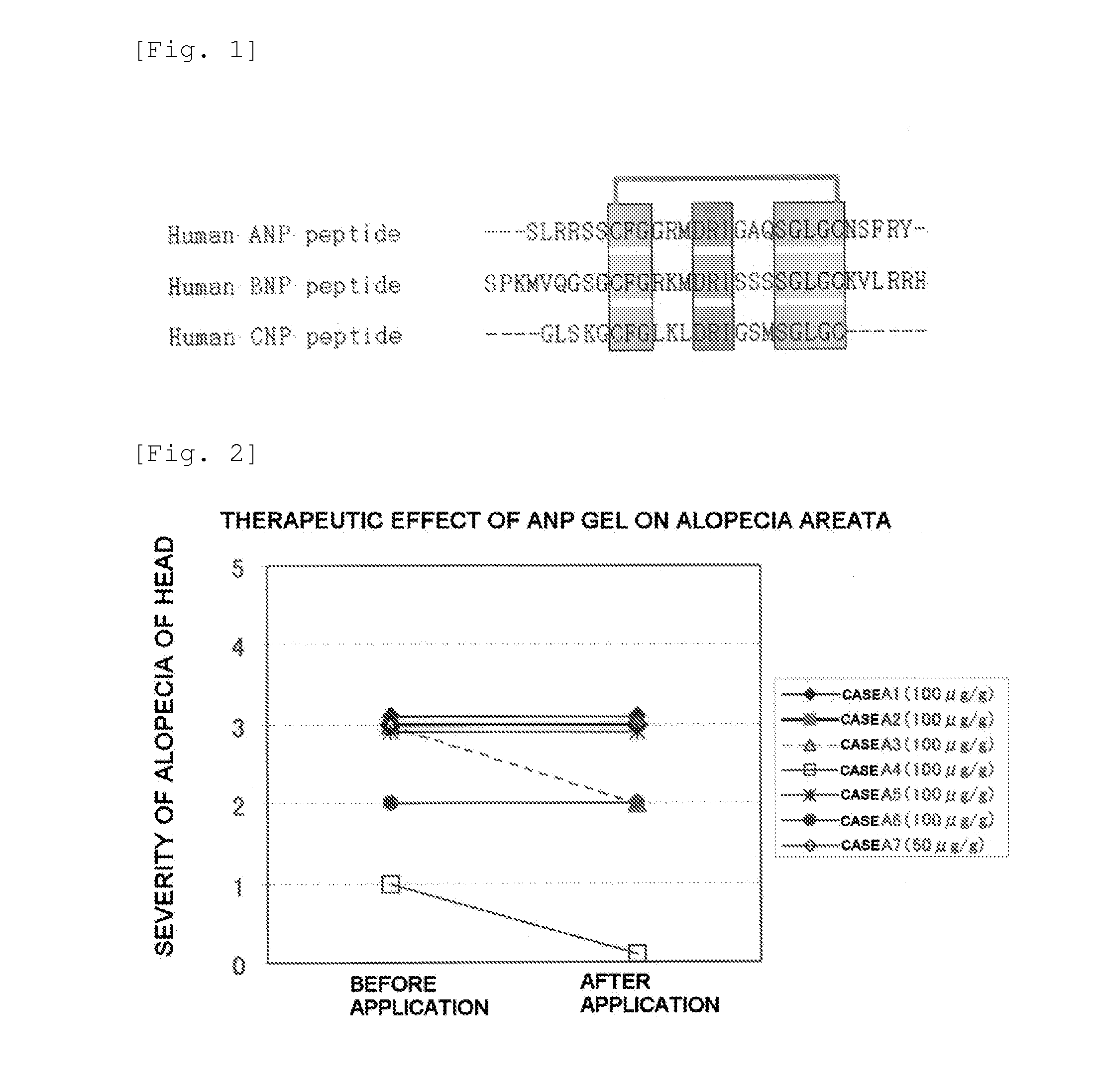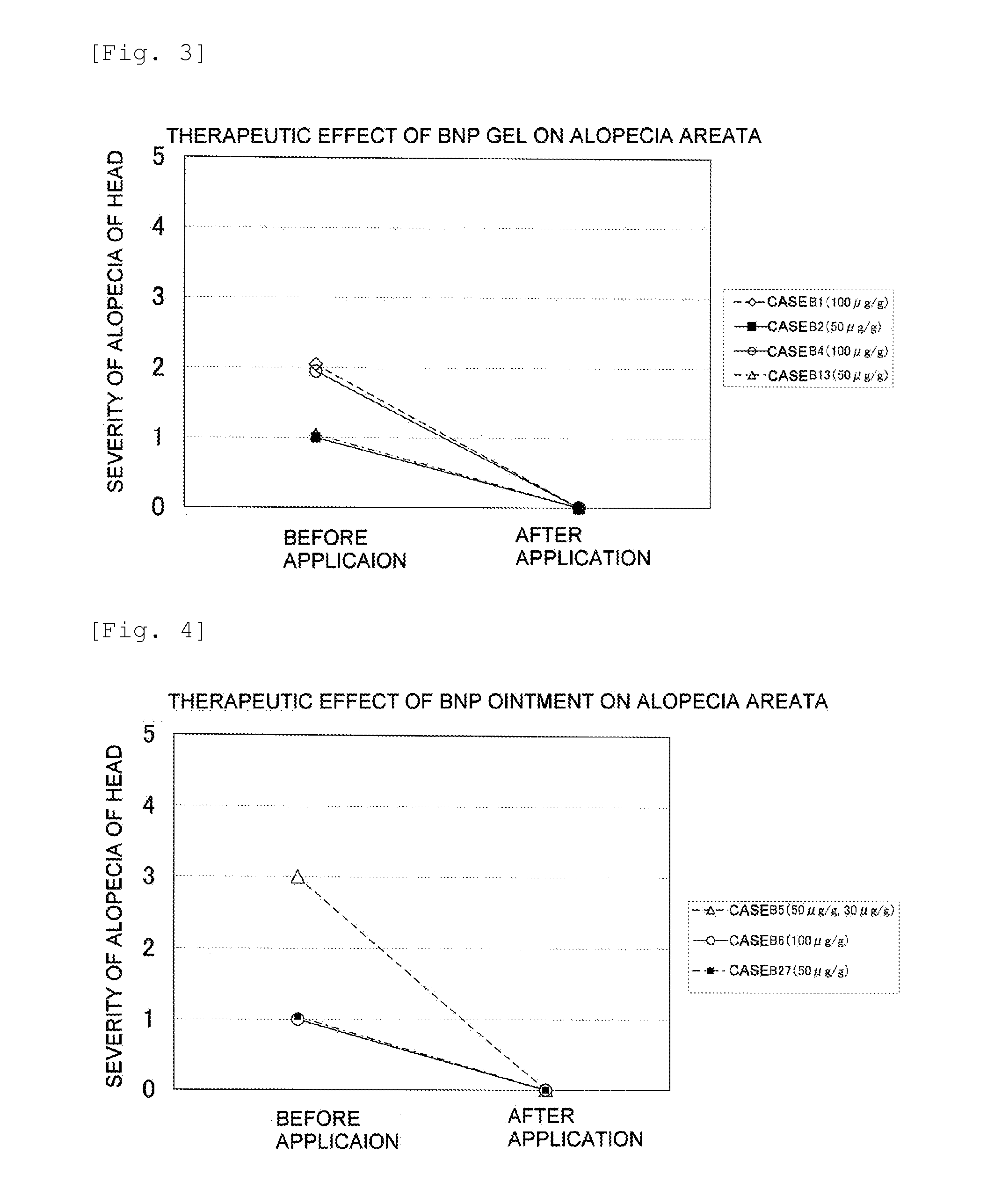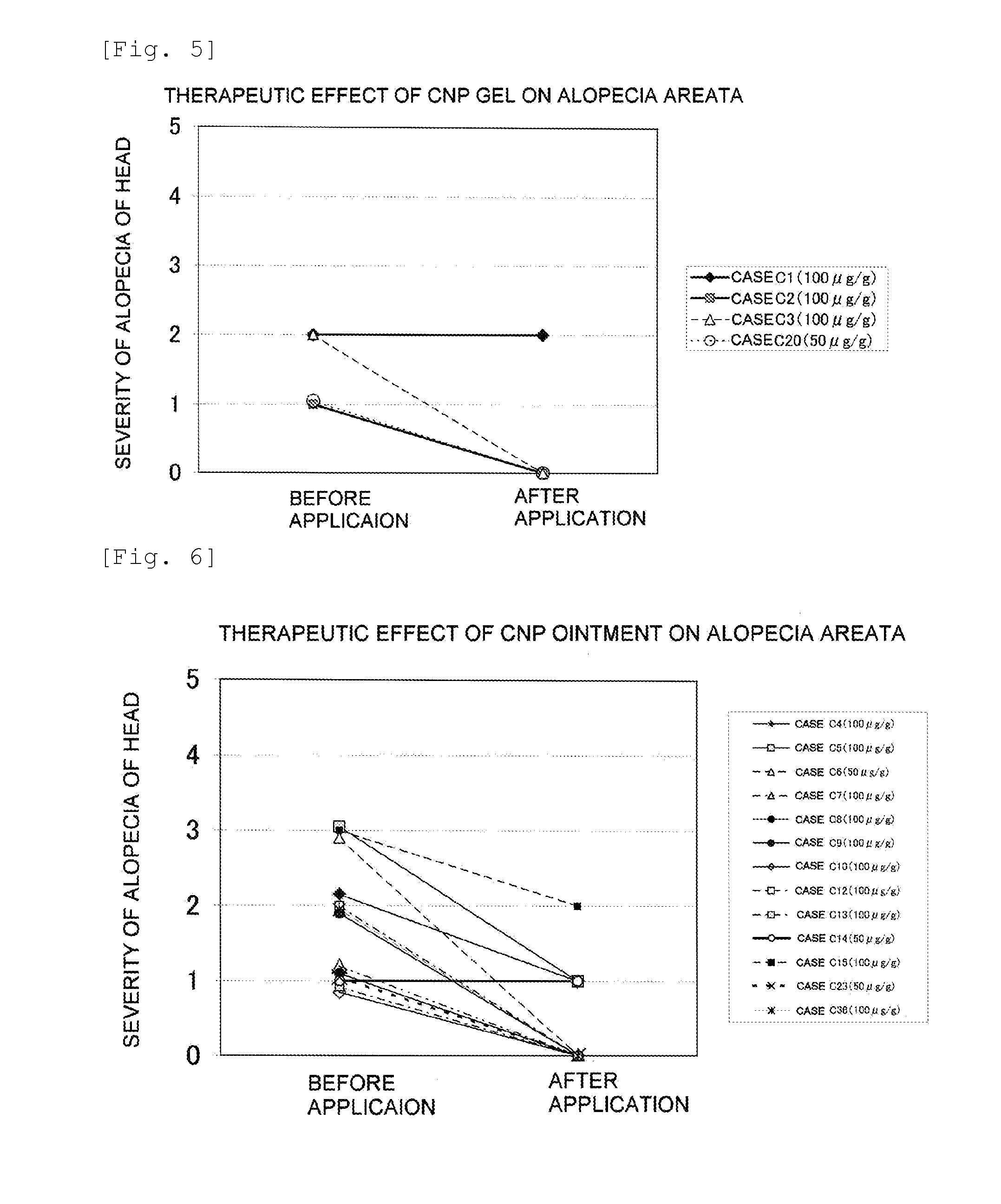Furthermore, it is thought that
postpartum alopecia, female pattern alopecia, seborrheic alopecia, alopecia pityroides, senile alopecia,
cancer chemotherapy drug-induced alopecia, and alopecia due to
radiation exposure have different causes from each other, and there are hardly any effective therapies.
Finasteride improves only about ¼ of patients for androgenetic alopecia in males, and since administration of
finasteride to females is contraindicated,
finasteride cannot be used for androgenetic alopecia in females.
Alopecia pityroides is often caused by excessive
hair washing; remission is achieved by reducing the number of times of
hair washing or using a
shampoo having a weak washing power, but it easily reoccurs and is intractable.
Furthermore, with regard to androgenetic alopecia, there is no adequate therapy yet, and with regard to
alopecia areata, even the cause thereof is little understood.
As described above, among the types of alopecia, the types of alopecia that are difficult to treat are
alopecia areata and androgenetic alopecia, and for alopecia areata in particular there are hardly any
effective treatment methods.
Although it is a
physiological phenomenon, its social effect is large due to the impression of the appearance being greatly affected.
Recently, a
minoxidil external
medicine and a finasteride
internal medicine, which are effective for androgenetic alopecia, have been developed and have also been actively used in a dermatological treatment, but it cannot yet be said that sufficient therapeutic effects are obtained.
Furthermore,
minoxidil has side effects such as drug-induced contact alopecia, hair
hyperplasia, decrease of
blood pressure, and decrease in
heart rate, and there is the problem that when its use is stopped the symptoms recur.
With female hormone drugs there is the possibility of
thrombosis.
Furthermore, finasteride has side effects such as
prostate hyperplasia,
erectile dysfunction, and ejaculatory disorder, when its use is stopped the symptoms recur, and it is contraindicated for pregnant women.
That is, although a hair thickening effect of finasteride on the crown or O-shaped site of androgenetic alopecia has been confirmed, there is no known evidence for a hair thickening effect on
hair loss in the
frontal region or M-shaped site.
Many patients with alopecia areata do not have a physical disorder other than
hair loss, but the patients are deeply worried, and the psychological damage and degradation of QOL are great.
Because of this, it is considered to be a
skin disease that must be treated using any possible method, but there are hardly any
effective treatment methods in the current situation.
Furthermore, the
recovery rate is also low for cases in which it developed at the age of 15 or younger or for alopecia ophiasis (Non-
Patent Document 12), and there is no recommendable therapy.
With regard to treatment for female pattern alopecia, finasteride is contraindicated in practice since it cannot be used for female pattern alopecia of a female who might be pregnant or a female who is breast-feeding.
As described above, there are hardly any
effective treatment methods for female pattern alopecia.
In these cases, if a
steroid is used for a long period, it often becomes difficult for hair to grow, and this requires attention.
As described above, when postpartum alopecia does not spontaneously recover, a
steroid cannot be used for the treatment thereof, and there are no other effective therapies.
With regard to the cause of seborrheic alopecia, it is thought that
inflammation is caused by abnormal growth of
indigenous bacteria on the
scalp due to excessive
secretion of sebum; a certain
therapeutic effect can be anticipated by appropriately removing sebum in the pores using a less irritating
shampoo, but it is difficult to maintain an appropriate level of sebum.
It is also said that proliferation of
Malassezia globosa, which is a type of
fungus, is one factor; there are cases in which
external application of an
antifungal agent shows a therapeutic effect, but since constitutional
secretion of excess sebum is the ultimate factor, it is difficult to improve, and there are hardly any treatments for seborrheic alopecia.
With regard to the cause thereof, it is said that
indigenous bacteria on the scalp proliferate abnormally due to an abnormal hormone balance, and this gives rise to hair loss.
As a treatment therefor, a
steroid treatment exhibits the highest effect among present therapies, but since this method might take a long time to achieve a complete cure or might easily result in a case in which the symptoms become chronic and the treatment becomes rather difficult, it is not a therapy that can be recommended.
The cause of senile alopecia is due to deterioration in the ability to produce new cells in the body caused by aging, and it is therefore difficult to treat.
Furthermore, even if
body hair recovers, since a state in which there is no
body hair continues for half a year to one and a half years, the appearance changes greatly during this period and this, coupled with
anxiety with respect to the cancer itself, causes considerable distress to the patient.
As described above, alopecia areata, androgenetic alopecia, female pattern alopecia, postpartum alopecia, seborrheic alopecia, alopecia pityroides, senile alopecia, and
cancer chemotherapy drug-induced alopecia not only have different causes from each other, but the therapies therefor are also very limited.
Moreover, with regard to androgenetic alopecia, a treatment using minoxidil or finasteride is recommended, but the effects thereof are weak.
Furthermore, for alopecia areata, steroid
local injection or local
immunotherapy are recommended, and although there are cases in which some effects can be seen, there are many cases in which no effects can be seen at all, and there are cases in which hair grows temporarily but when treatment is stopped the situation deteriorates due to steroid rebound.
Because of this, the possibility of administration of CNP being able to prevent intravascular
restenosis, which occurs with a certain frequency among patients with an
ischemic heart disease after receiving
percutaneous transluminal coronary
angioplasty (PTCA) and is a clinical problem, is currently being examined in terms of clinical application.
However, none of these publications refer to a relationship between natriuretic peptides and specific types of alopecia such as alopecia areata, androgenetic alopecia, alopecia pityroides, postpartum alopecia, female pattern alopecia, seborrheic alopecia, trichotillomania, and senile alopecia.
Furthermore, none of these publications demonstrate that CNP or BNP is useful for the treatment of alopecia.
However, this means the use of CNP as an agent for the inhibition of
smooth muscle cells and does not suggest the application of CNP or BNP to an agent for the treatment of alopecia.
However, this concerns utilization of the action of ANP, BNP, and CNP in promotion of lacrimal
secretion as an eye dropper for the treatment of keratoconjunctival disorder, and does not suggest the application of CNP or BNP to an agent for the treatment of alopecia.
However, the intention was to utilize CNP as a composition for increasing height based on the knowledge that the length between the
nose and the
anus is larger for a transgenic mouse overexpressing CNP than for a normal littermate, and does not suggest any application of CNP or BNP to an agent for the treatment of alopecia.
However, this is only a finding that in a transgenic mouse overexpressing CNP, the thickness of the
articular cartilage is large compared with a normal littermate, and when CNP is continuously administered to an
arthritis model animal, the
arthritis is suppressed, the intention being to utilize CNP as an agent for the treatment or prevention of
arthritis, and does not suggest the application of CNP or BNP to an agent for the treatment of alopecia.
However, this does not suggest the application of a natriuretic peptide to an agent for the treatment of alopecia and does not mention CNP at all.
However, the intention was to use a natriuretic peptide for prevention of
cirrhosis of the liver or
liver cancer, and there was no suggestion of the application of a natriuretic peptide to an agent for the treatment of alopecia.
However, the intention was to use a natriuretic peptide for suppression of peritoneal
fibrosis at the time of
peritoneal dialysis and there was no suggestion of the application of a natriuretic peptide to an agent for the treatment of alopecia.
However, the intention was to add ANP to a
peritoneal dialysis solution and apply it to the treatment of a patient with
kidney damage, and there was no suggestion of the application of a natriuretic peptide to an agent for the treatment of alopecia.
However, the intention was to apply ANP to the prevention or treatment of a Th1 immune
disease such as Crohn's disease, and there was no suggestion of the application of a natriuretic peptide to an agent for the treatment of alopecia.
Furthermore, in Example 3 of the same publication, it was reported that when ANP was applied twice a day after
hair washing to the scalp of ‘54 year old and 89 year old males with thin head hair’, ‘downy hair-like
hair growth was observed on the
frontal region with 1 week of ANP administration, and sites started to appear where
black hair papilla appeared after hair had fallen out’, ‘after 2-3 weeks, resilience and rigidity increased for the
entire head hair’, and ‘after 1 month the scalp, which could been seen before use, was obviously difficult to see’.
Furthermore, said publication only considers a ‘drug for hair growth, hair restoration, and hair thickening’ as a very broad concept; it is unclear whether it is a treatment agent or a preventive agent, and it does not suggest a treatment or preventive agent for a specific alopecia and does not suggest a treatment or preventive agent for dandruff, white hair, and seborrheic scalp.
 Login to View More
Login to View More 


